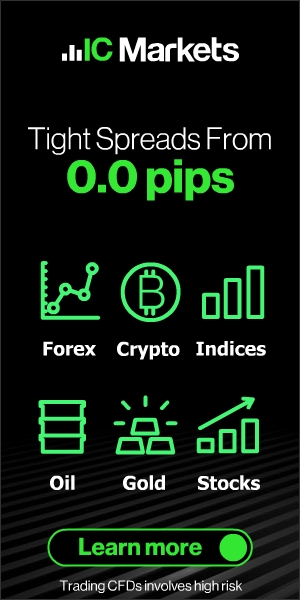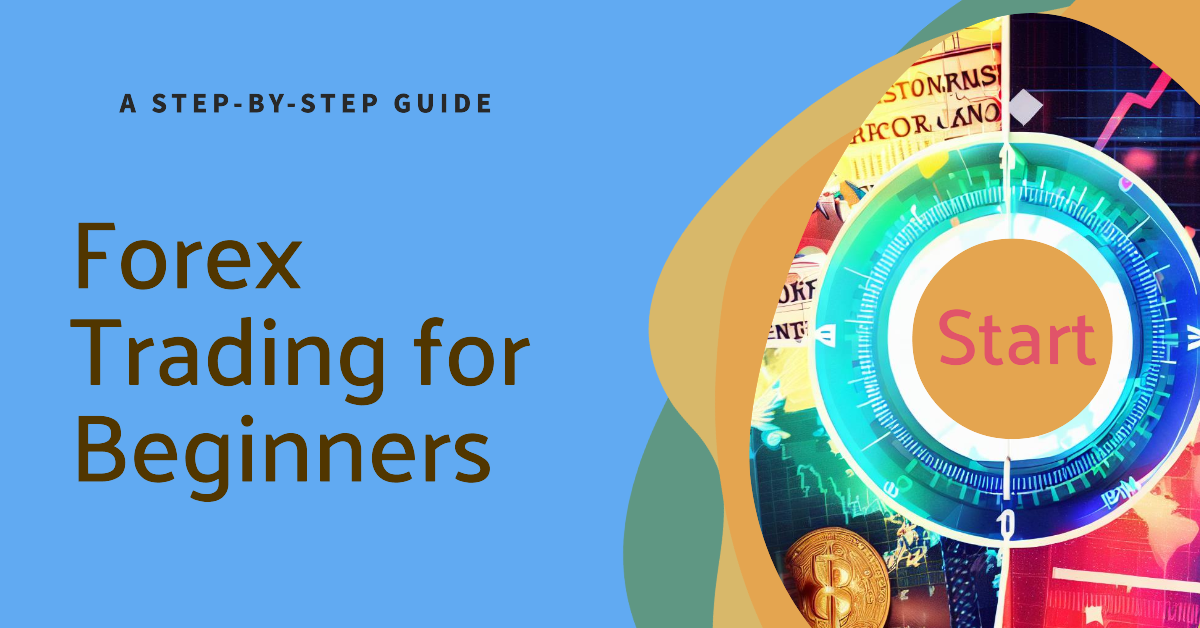
Forex Trading for Beginners: A Step-by-Step Guide
- Jonny Smith
- June 30, 2023
- Forex Trading For Beginners
- Best_forex_broker, ecn, forex, Froex_Demo_Accounts, strategies
- 0 Comments
Hello, my soon-to-be Forex master! 😎👋
Are you ready to dive into the big waves of currency trading?
Don’t fret; I’ve got your back. This article is your treasure map, guiding you through the forex markets like Columbus sailing through the Atlantic (but with fewer sea monsters and more profits). 🗺️🚢
Step 1: Know Thyself (and the Forex Market) 🧐📚
First things first. Like a wise trader once said, “Know thyself, and thou shall conquer the markets”. Well, maybe a trader didn’t say that, but you get the gist. Before you begin, it’s important to understand the basic principles of Forex trading.
What is Forex Trading? 🌍💱
Forex (foreign exchange) trading involves buying and selling currencies against each other. It’s like going to a foreign exchange counter at the airport, but on a much grander scale, and you’re not buying souvenirs. 🛍️
Why Trade Forex? 🤷♂️💰
Forex markets are open 24/5, offer high liquidity, and let you trade on margins. Imagine, you can be in your PJs and still making trades. 🌛
Step 2: Choose Your Warrior (Broker) ⚔️🛡️
Choosing a Forex broker is like choosing your favorite Avenger – you need someone who has all the cool gadgets and can guide you through the battle.
What to Look For:
- Regulation: Make sure the broker is regulated by a reputable authority.
- Trading Platform: Check if their trading platform is user-friendly and packed with essential tools.
- Customer Support: Find out if they will have your back in a Forex crisis. 💪
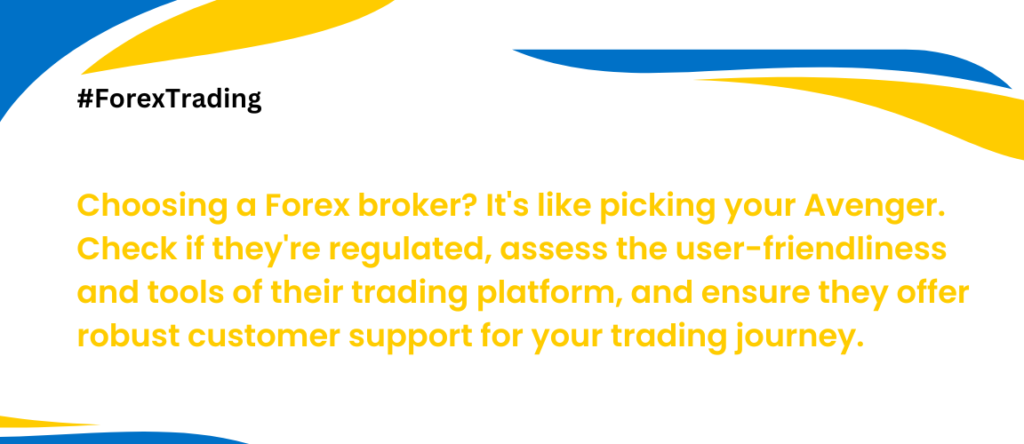
Step 3: Build Your Arsenal (Education & Tools) 🧰📈
Now, you need to gather your weapons – the knowledge and tools that will help you navigate the stormy seas of Forex.
Educate Yourself:
- Read Books: Forex trading books are your treasure chests. 📚
- Online Courses: Enroll in courses like a pirate hungry for gold.
- Stay Updated: Keep an eye on economic news and global events. 👀
Tools:
- Trading Platforms: Choose a trading platform that fits your style, like MT4 or MT5.
- Charts and Analysis Tools: Learn to read charts like a pirate reads maps. 🗺️
Step 4: Plan Your Journey (Trading Plan) 🗺️📝
Like every epic quest, you need a plan.
- Set Goals: Define what you want to achieve.
- Risk Management: Decide how much treasure you’re willing to risk. 💰
- Analysis: Choose between fundamental or technical analysis or a combination of both
Step 5: Set Sail (Start Trading) 🚢💨
It’s time to set sail! But remember, the sea can be rough.
- Demo Trading: Start with a demo account. It’s like training wheels for Forex trading.
- Live Trading: Once you’re ready, switch to live trading. Be cautious and disciplined.
Step 6: Learn From The Seas (Review and Learn) 🌊🎓
The sea is a great teacher. Learn from your trades, review your strategies, and never stop improving.
Step 7: The Right Trading Style: Pick Your Poison 🎩💼
Now that you’ve set sail, it’s time to pick your trading style. You have four major styles to choose from:
1. Scalping 👀⏲️
Scalpers make rapid and frequent trades throughout the day, aiming to scoop up small price differences. It’s fast-paced, so buckle up!
2. Day Trading 🌞📊
Day traders also make multiple trades within a day, but unlike scalpers, they aim for larger profit margins. Trades are opened and closed within the same day, no overnights!
3. Swing Trading 🏌️♂️📉
Swing traders, they’re like the jazz musicians of the trading world. They hold trades for days to weeks, aiming to catch ‘swings’ in the market.
4. Position Trading 🚪🔑
Position traders are the cool, patient ones. They hold trades for weeks, months, even years, aiming for the big wins.
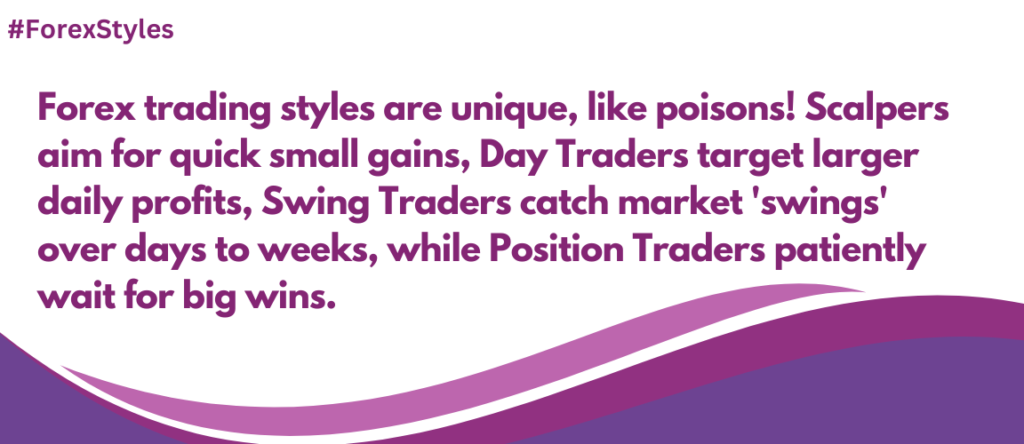
Step 8: Understanding Forex Quotes and Pairs 📝💹
In Forex, currencies are quoted and traded in pairs. For example, EUR/USD. Here, EUR is the base currency, and USD is the quote currency.
If EUR/USD is quoted as 1.2100, it means 1 Euro is equivalent to 1.21 US Dollars. Simple, right? 😏💱
Step 9: The Art of Analysis 🎨📊
Forex trading isn’t all numbers and charts; it’s an art too! There are two main types of analysis in Forex:
1. Fundamental Analysis 📰💼
Fundamental analysts interpret economic news, events, and financial statements to predict future price movements.
2. Technical Analysis 🔍📈
Technical analysts study past market data, primarily price and volume, using various tools and techniques.
A good trader is a good artist, using both types of analysis to paint their trading masterpiece.
Step 10: Embrace Risk Management 🤗⚖️
Remember the pirate code? “Those who risk too much, lose too much.” It’s critical to have a risk management plan in place. Never risk more than a small percentage of your trading account on a single trade.
Step 11: Learn the Lingo 🗣️💬
Welcome back, savvy seafarer! Now that you’ve got the basics down, let’s learn some Forex lingo. It’s like a pirate’s parrot; without it, you’d feel a little out of place.
Pips: 💡
Pips are the smallest price change that a given exchange rate can make. For most currency pairs, it corresponds to the change of the fourth decimal point, like 0.0001.
Lots: 📊
Forex is traded in amounts called lots. One standard lot> has 100,000 units of the base currency.
Leverage: 💪
Leverage is like a loan provided by the broker to the trader, enabling you to trade larger positions than your account balance.
Margin: 💰
Margin is the amount of money needed in your account to maintain your market positions using leverage.
Step 12: Unravel the Mystery of Forex Charts 📉📈
Trading without understanding Forex charts is like sailing without a compass. Let’s unravel this mystery:
Line Chart: 📈
The simplest type of chart, showing the closing prices over a specified period.
Bar Chart: 📊
A bit more complex, it shows the opening and closing prices, as well as the highs and lows.
Candlestick Chart: 🕯️
The most detailed chart, it shows the open, close, high, and low prices. They are color-coded for easier visualization of market movements.
Step 13: Decoding Forex Indicators 🔍🔢
Forex indicators are like secret codes, helping you predict future price movements. Some popular ones include:
Moving Averages: 🚚🔢
This indicator shows the average price over a specified period, helping to smooth out price fluctuations.
Relative Strength Index (RSI): 💪🔢
This indicator measures the speed and change of price movements, often used to identify overbought or oversold conditions.
Moving Average Convergence Divergence (MACD): 🚚⚖️
This trend-following momentum indicator shows the relationship between two moving averages of a pair’s price.
Step 14: Demo Trading: Practice Makes Perfect 🏋️♀️💼
Before you jump into the deep end of the Forex pool, try out a demo account first. It’s like a trading simulator where you use virtual money to practice your trading skills without risking a penny. It’s a brilliant way to learn the ropes and test your strategies. Remember, in the world of Forex, practice truly does make perfect!
Step 15: Choosing a Reliable Forex Broker 🤝🔍
Like a trustworthy parrot on a pirate’s shoulder, a reliable Forex broker is an essential companion for your trading journey. Here’s what you need to consider when choosing a broker:
Regulation: 📜🔒
Ensure your broker is regulated by reputable financial authorities. This offers protection and security for your hard-earned treasure.
Trading Platform: 🖥️📱
A user-friendly trading platform with necessary tools and features makes your trading journey smoother.
Customer Service: 🤝📞
Because everyone needs a helping hand sometimes, right? Good customer service is invaluable, especially in the confusing early days.
Step 16: Make Your First Trade 🚀📈
You’ve done your homework, practiced on a demo account, chosen a reliable broker – now, it’s time to make your first trade! Here’s a step-by-step guide:
1. Open your trading platform 💻📱
Fire up that trading platform. It’s time to put all your learning into action!
2. Choose your currency pair 💶💵
Remember what we said about Forex pairs? Now’s the time to pick one.
3. Decide on the type of trade 📉📈
Are you going long (buying) or going short (selling)?
4. Set your lot size 📊🔢
Decide how many units of the currency you want to buy or sell.
5. Set your stop loss and take profit levels ⏳💰
These are your safety nets, protecting you from unexpected market waves.
6. Click the ‘buy’ or ‘sell’ button 👆💵
And just like that, you’ve made your first Forex trade. Congrats!
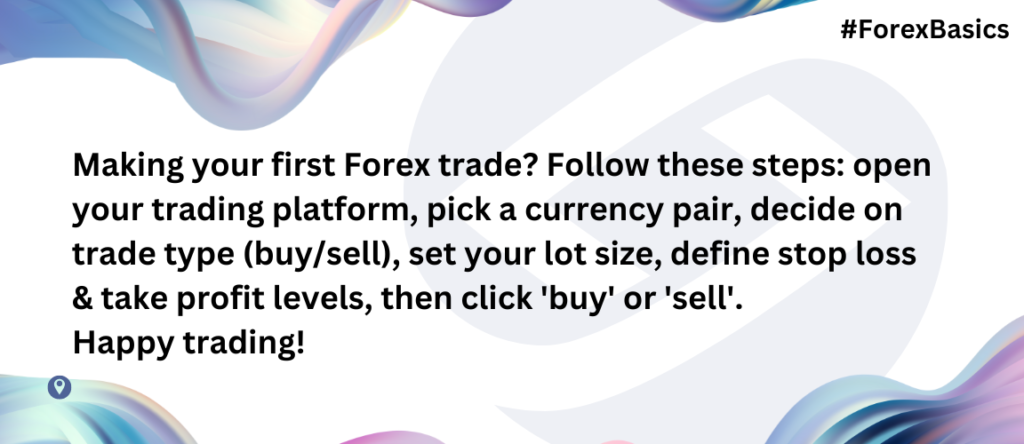
Conclusion: The Forex Sea is Yours to Conquer 🌊⚔️
Well done, mate!
You’re no longer a beginner. You’ve equipped yourself with the knowledge and tools you need to start trading Forex. But remember, the learning never stops. Keep exploring, keep improving. The Forex sea is yours to conquer. If you’re eager for more knowledge, just say “continue”. Until then, fair winds and following seas! 🌬️⛵️


